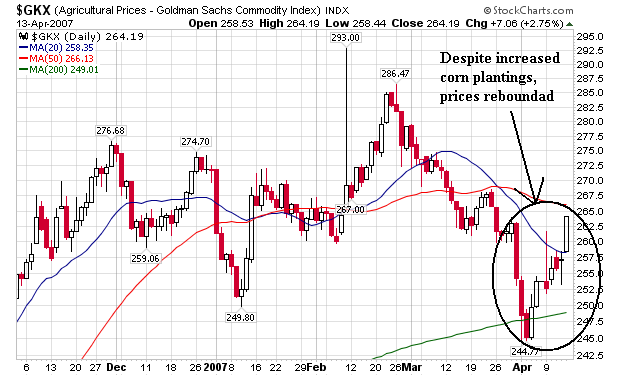From the blog, Financial Sense
Thanks to Federal mandates and subsidies, corn used for the production of corn ethanol is expected to increase from ~ 700 M Bushels in 2000/2001, to 3.2 B bushels in 2007/2008 – an increase of 357 percent. On December 11, 2006, the USDA estimated 2006-2007 U.S. ending stocks would be 935 million bushels, down from 1.97 billion bushels in 2005-2006. That decreases the ending stocks by more than 50 percent and puts the ending stocks to use ratio at 8%, - the lowest in 11 years. It should be obvious to all, we are going to need a lot more acreage and big yield improvements if corn production is going to keep up to demand. Prices could exceed $4.50 per Bu by the end of 2008. That’s a price increase of 125% over 2005/2006 season prices.
Let's take this one point at a time.
...corn used for the production of corn ethanol is expected to increase from ~ 700 M Bushels in 2000/2001, to 3.2 B bushels in 2007/2008 – an increase of 357 percent.
In other words, demand hasn't just increased; it has spiked off the map. Econ 101: increased demand equals increased price.
On December 11, 2006, the USDA estimated 2006-2007 U.S. ending stocks would be 935 million bushels, down from 1.97 billion bushels in 2005-2006. That decreases the ending stocks by more than 50 percent
Supply is contracting as well, and not by a little. By a lot. Econ 101: decreased supply = increased price.
It should be obvious to all, we are going to need a lot more acreage and big yield improvements if corn production is going to keep up to demand. Prices could exceed $4.50 per Bu by the end of 2008. That’s a price increase of 125% over 2005/2006 season prices.
To respond to the increased demand farmers planted more corn this year. This is why the daily agricultural prices dropped a few weeks ago. But notice prices are right back up to to where they were a few weeks ago.
This situation in the corn market is impacting all other agricultural products as well -- everything is going up in price. Here's the daily chart.

Also notice that on the long-term chart we have a two year bull market. It's hard to stop a trend like this, especially with the above mentioned supply/demand situation. Also note the price rebound from the news of increased corn plantings is apparent on this weeklychart -- that's how strong the rebound was.

And it's not just corn that's increasing in price. Remember corn is a basic ingredient in a ton of food.
If corn prices increase by ~ 55 percent, year over year, then will the corn used for hog, cattle, chicken, turkey and fish feed go up 55 %? Doesn’t that increase the price of meat, poultry, fish, milk and eggs? If corn is used in corn meal, corn flakes, corn oil, and hundreds of other food items goes up 55%, doesn’t that increase the price of all these foods? Maybe. Since 2000, the price of beef is up 31%, eggs up 50%, corn sweeteners up 33%, wet corn milling up 39%, and corn flakes are up 10%. Chicken prices haven’t changed very much. Yet. Food producers are predicting higher prices.
So, here's the summation. Food prices are going up. The ethanol mandates are increasing demand. Although farmers planted more corn this year, supplies are still dwindling. Econ 101: increased demand plus decreased supply = increasing prices.